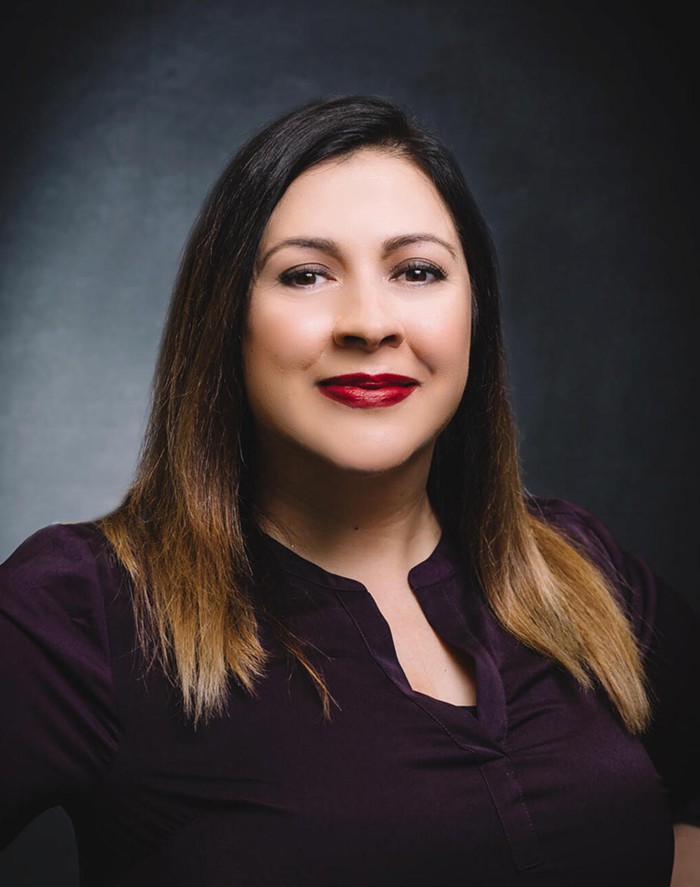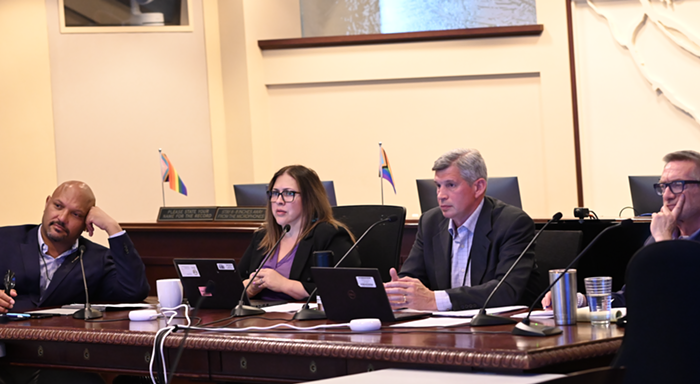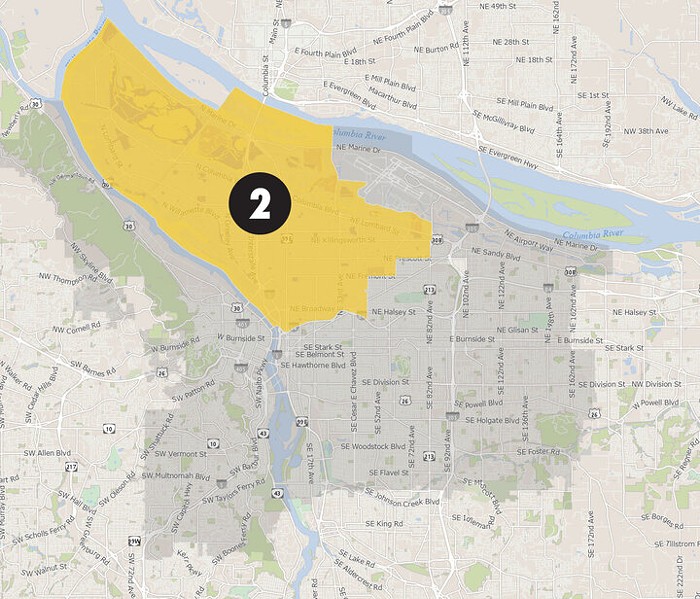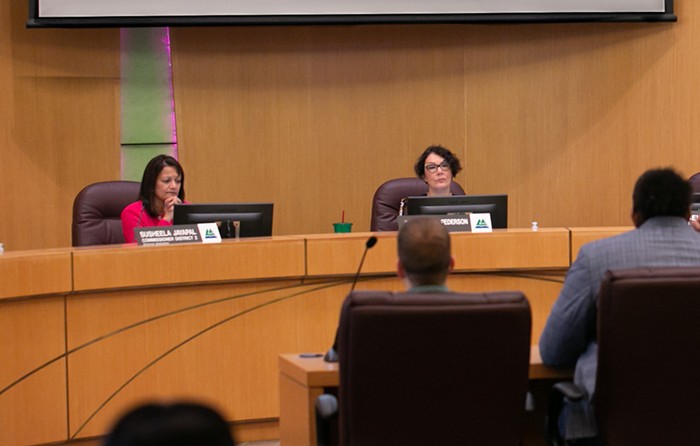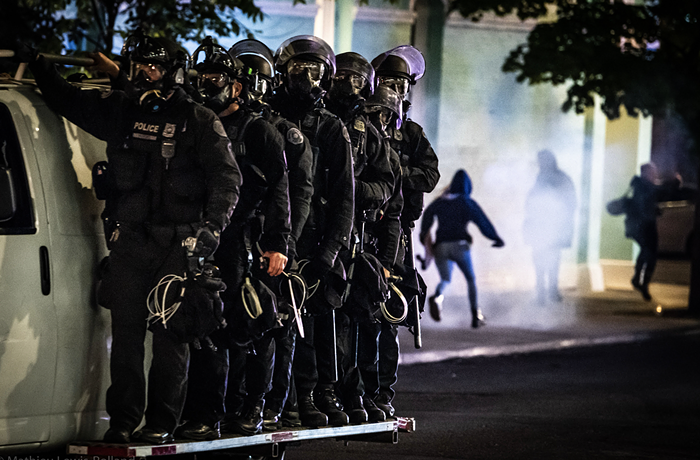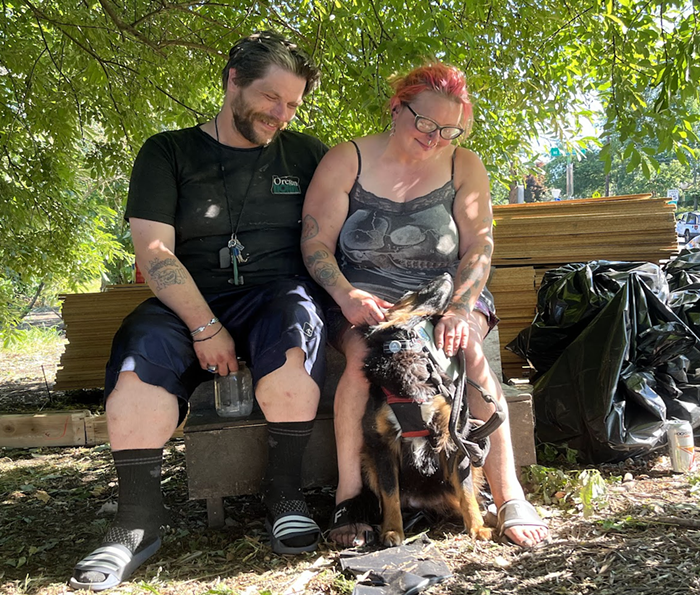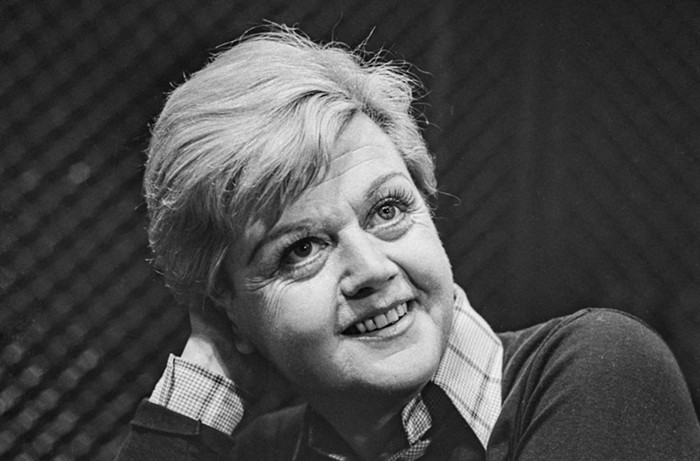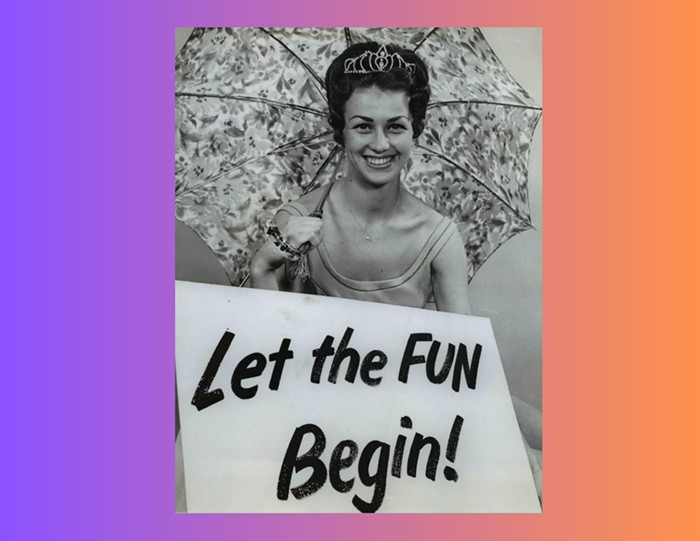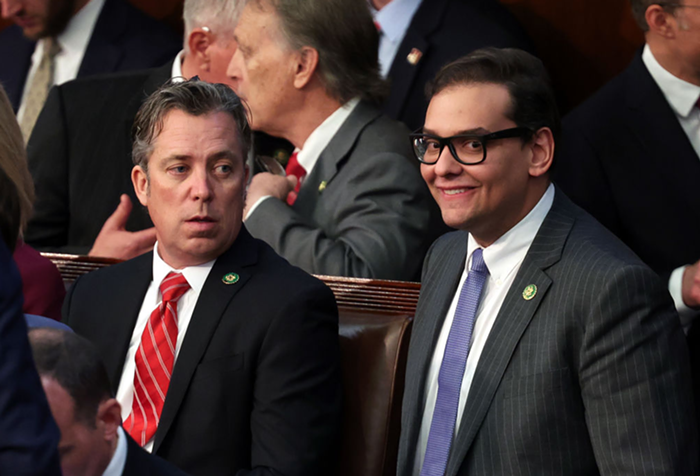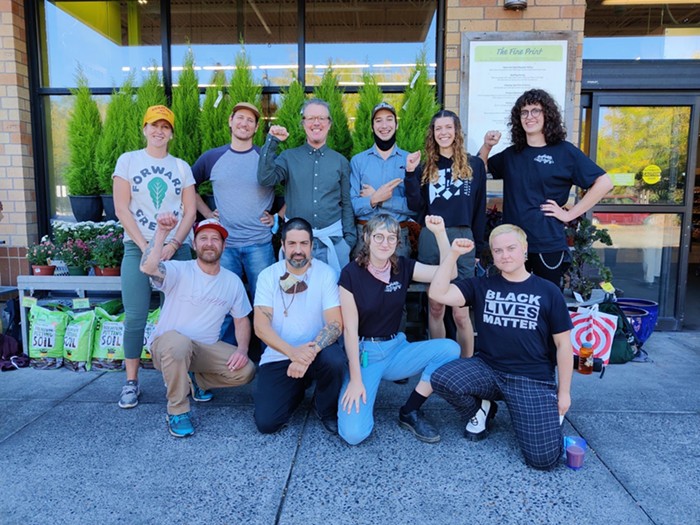THIS TIME, the smartly dressed Bishop Steven Holt wasn't presiding onstage, clutching a mic the way you might imagine him leading a sermon.
Instead, he was sitting down—though still impeccably dressed. There was a microphone, resting a few inches from his face, though it was hardly a personal instrument of rhetoric. This time Holt was sitting across from the stage—shoulder to shoulder with the city's housing director—waiting to address the expectant faces of Portland's city commissioners.
So much of Holt's visit to council chambers was different from the speeches he'd been giving—at a series of community forums starting last fall—on how the city ought to spend $20 million over the next five years to fight gentrification in Portland's traditional African American neighborhoods.
But the history lesson he was about to recite was the same. Holt traced the black community's long road from Vanport and redlining, to disinvestment and destruction, followed by renewal that's largely left out, and pushed out, longtime and beleaguered residents.
"In 1990, you see what I call the 'dark chocolate' extending," he said while explaining color-coded maps showing the spread of African Americans across North and Northeast Portland and their eventual decline. "And then we see 2000... there's a switch, not as much. In 2010, there's almost an absence of the dark chocolate, where African Americans were concentrated."
His well-worn warning was also the same.
"There have been promises that have been made that weren't kept," he reminded the council.
Holt could've been speaking directly to just Mayor Charlie Hales and Commissioner Dan Saltzman. Both have spent years in politics, presiding over past plans to help Albina and Boise-Eliot. And both were instrumental in plotting this new $20 million plan, which Hales hoped to spread like salve, after outcry over an aborted plan to put a Trader Joe's at NE MLK and Alberta. The grocer had bailed on Portland after African American neighbors clamored for more housing and a bigger voice in shaping city policy.
"What we're trying to do," said Holt, a respected pastor who's agreed to lead a first-of-its-kind community panel tasked with watching over the $20 million, "is to make sure that doesn't happen again."
But this time, even a kept promise might not be enough.
The city's $20 million plan is laudably substantial. But officials already acknowledge it's really just a start. Spent as smartly as possible, that money will help only a few hundred families in a relatively concentrated part of North and Northeast Portland. The money will be split between building new apartments, helping longtime neighbors fix up fading homes, and giving a lifeline to would-be homeowners looking to move in.
At the plan's heart is an acknowledgment of the city's sins and an implied "right of return" for some of the African American families who were scattered north and east over the past 15 years by rising home prices and a desertion of black-owned businesses and institutions. The city, however, must tread lightly when extending preferential treatment to people who might wish to come back. Because of fair housing laws, it's not allowed to consider race—extending preferences, instead, based only on someone's housing history. Whether they're white or black.
And that's assuming anyone wants to move back to a changed place where the new residents might not be so happy to see them. Where the bars and stores they knew are gone. Where a cup of drip coffee costs $3, poured by a white kid in skinny pants.
Bishop Holt and the city seem to be betting they might. Not everyone is so sure.
"That's a pipe dream," says JoAnn Hardesty, president of the local chapter of the National Association of the Advancement of Colored People (NAACP). "It would be like putting people in a desert without any water."
An Origin Story
IT'S MAYBE WORTH mentioning that this particular conversation—this tentative airing of hopes and dreams over what's been a sore subject for decades—almost didn't happen.
On March 10, 2014, still hoping to revive the city's failed deal with Trader Joe's, Hales tried to play peacemaker by inviting advocates who'd complained the loudest about the city's process and priorities to city hall.
Then he dropped a bomb.
At his and Saltzman's urging, the Portland Development Commission (PDC) would spend $20 million more than budgeted or required on affordable housing in the urban renewal area whose boundaries encompassed the Trader Joe's site and much of the city's traditional black community.
Hales' surprise move got the city's leading Trader Joe's skeptic—the Portland African American Leadership Forum (PAALF)—to stand at the mayor's side and cheer the "start to a path of victory."
It was an important gesture. PAALF, along with the NAACP, had been strident critics of what some felt was top-down decision making at the hands of the mayor and PDC. Not everyone in the city's African American firmament agreed, but the critics' voices carried.
They invoked the city's dark days of slum-clearing and questioned the steeply discounted sale price that had been negotiated with the Southern California developer, Majestic Realty, in business with Trader Joe's. They hated that the city was finally investing in NE MLK now, seemingly only after it was turning white, and demanded affordable housing on the site—either atop or instead of the grocery store.
And now, months later, Hales had pulled his critics over to his side. Not that it mattered. Trader Joe's never came back, leaving the city to court the even more upscale Natural Grocers instead.
Hales' multimillion promise, meanwhile, was still on the table. It was more than anyone had hoped or expected.
"None of this $20 million would've needed to happen if the mayor had just put housing on that site," noted one source close to the discussions. "I appreciate it on the flipside. It's nice. But the lessons of racism and the lack of good governance are expensive. The mayor freaked out because there was a schism within the black community over this property. It was more convenient for him to avoid the fight by spending money."
Patrick Quinton, executive director of the PDC, remembers things a little bit differently.
He said officials at the urban renewal agency had already been talking about moving money around the city's Interstate Corridor Urban Renewal Area for a few months, when the Trader Joe's controversy came to a head. Rising property values were bumping up tax revenue forecasts, giving planners more money to play with. And demand for business loans and commercial projects had stayed soft.
"We could try to squeeze water from a rock," says Quinton. "But this area seems to be screaming out for more affordable housing investments."
Those discussions stayed loose until Hales was ready to play ball ahead of the March meeting. PDC set to work sharpening its numbers and had a formal presentation in time for the huddle with advocates.
"This can be more than just talk," Quinton remembered thinking. "We can show real numbers."
All told, Quinton says about half of the $20 million came from tapping new revenues, with $6 million carved out of contingency funds. Just $4 million wound up properly reallocated from other projects, like commercial programs and streetscape work. (That money's on top of the 30 percent of revenues PDC already sets aside for affordable housing. That sum's expected to top $16 million over the next five years.)
But would we have that money right now, and not next year or the year after, if Hales hadn't been immediately hunting for a solution to the Trader Joe's fracas?
"I don't know what would have led to us formally bringing it forward if the situation hadn't arisen," Quinton says. "It's legitimate to say it came as a result of the Trader Joe's thing. But it wasn't like we were at the 11th hour scrambling around to do something. We were already thinking about the big picture."
It's Not the Same Place
THE SKY CRANES and fancy bike lanes and SE Division-style apartment canyons taking shape on N Williams and N Vancouver serve as the latest examples of how things have changed in the past 15 or 20 years. (Honorable mention: the new Purringtons Cat Lounge on NE MLK.)
But the numbers tell an even more dramatic story.
The Mercury last fall printed devastating census maps put out by the Portland Housing Bureau at a series of public forums on what do with the $20 million ["Worth a Thousand Homes," News, Oct 1, 2014]. Decade by decade, starting in 1970, they showed the zenith—and then the disintegration—of vibrant inner-city neighborhoods that had been built and consolidated by disaster (the flood of Vanport) and racism (redlining and dishonest bank lending).
In 1990, African Americans made up 31 percent of the people living in a swath of Portland roughly bound by Columbia Villa and Swan Island, NE 33rd, Interstate 84, and Columbia Boulevard. That number, in 2010, had fallen to 15 percent.
More striking, there isn't a single majority-black census tract left in that entire zone. Some 11,500 African Americans moved away, even as the area's overall population grew. Black businesses and even some churches—Holt's International Fellowship Family, among them—followed. Even the black-owned Skanner newspaper at one point mused about moving its offices east.
As Holt lays out in his well-traveled history primer, the blows began falling as early as the 1950s, when Interstate 5 and Veterans Memorial Coliseum smashed through the Rose Quarter and parts of Albina. The hits kept coming in the 1960s, courtesy of the PDC's prescriptions for renewal and Legacy Emanuel hospital's infamously impotent land grab on N Williams, destroying a distinctive commercial district.
But ironically, it was the city's own attempts at atonement that sped up the scattering.
City council passed the Albina Community Plan in 1993, with plans to build and rehab thousands of homes, helping "current and future residents." Seven years later, the city created the Interstate Corridor Urban Renewal Area and set the stage for the arrival of a new MAX line. Investment followed—especially after more white people, pushed out by rising costs in other neighborhoods, found their way north.
"It breaks my heart every time I go over to inner Northeast Portland now," says Hardesty, the local NAACP leader and a former state lawmaker. "It's hard to go through there, knowing the lack of investments 20 years ago when it was predominantly an African American community and the only services we could get were police services."
When Governing magazine last month declared Portland the fastest-gentrifying city in the country, its own interactive census maps contributed another piece of the picture.
In the census tract bound by NE Fremont, NE Skidmore, NE MLK, and N Mississippi, median home values have jumped 107 percent since 2000, up to $325,000. That tract's also seen a 30-percentage-point gain in residents claiming college degrees over the same span. It's roughly the same story several blocks away, in the census tract bound by NE MLK, NE 15th, NE Prescott, and NE Killingsworth, and also around Legacy Emanuel.
"There's no way people can afford to live here," says Reverend Lynne Smouse Lopez, pastor at Ainsworth United Church of Christ at NE 29th and Ainsworth. "They're forced to look at Vancouver or Gresham or elsewhere."
Lopez still hears occasional stories of women driving in from Lake Oswego because "they don't have access to African American hairdressers who know how to style African American hair."
But when she talks to other pastors, she knows even that's changing. Gentrification's about more than just housing. It's about every other piece of what makes up a neighborhood. PDC officials say they still see some chance to turn around NE MLK. But there's nothing in the city's $20 million strategy that directly takes on business retention.
"It's made it hard for African American businesses to stay because their people are moving farther away," says Lopez. "Everything is getting uprooted."
Nuts, Bolts, and Tripwires
THE CURRENT VERSION of what's now known as the "North/Northeast Portland Housing Strategy" began to coalesce last summer and fall under the auspices of the housing bureau, overseen by Saltzman's office.
Housing officials, charged with spending PDC's $20 million, were determined not to repeat the mistakes of Portland's past. Or at least they'd try.
They met with ministers, nonprofit leaders, community groups—anyone who'd have them—in search of ideas and advice. More importantly, they plotted four major public forums—in Albina, but also in East Portland and Gresham—and invited citizens to dine on catered food while perusing poster-size maps and sharing their hopes and fears. Officials say they wound up hearing from 450 people, either at events or in emails or written comment cards.
"We got really positive responses," says Traci Manning, director of the housing bureau. "It resonated."
The spending plan presented to city council for approval on January 28 embraced many of the public's ideas. It also struck a delicate balance. Some advocates pushed quietly for more land-banking. Some demanded more development. Others insisted the city do more for homeownership—building on work by prominent black-run nonprofit Portland Community Reinvestment Initiatives, Inc., whose leader, Maxine Fitzpatrick, attended the housing bureau's forums.
But at the bottom of it all was a concept Manning says Saltzman championed early on in the discussions: the notion that city officials should do more than just keep African Americans from leaving—officials should also make it easier for people who left to come back. That early emphasis helped ensure it was planted firmly in the minds of the public and advocates.
As such, just a chunk of the $20 million—$4 million—was marked for one of the most cost-effective but least dramatic options on the city's menu: loans for home repairs. Officials estimate those infusions could help as many as 240 families stuck in ancestral homes they can't afford to fix, sparing them the indignity of selling to home-flippers and moving away.
The rest of the money, instead, will be spent on efforts that offer a chance at a homecoming.
More than a third of the cash—$8 million—will be spent developing as many as 140 rental units priced for people earning no more than 60 percent of the region's median income. (The city's already eyeballing land it owns near NE Cook and NE MLK.) An additional $5 million will be spent on down payment assistance and the gathering of a small stockpile of affordable houses (more than 30) for purchase. And $3 million more will help snap up and stash land, more expensive with each passing year, that might one day make sense to build upon.
(One nit? The $20 million, because it's from the PDC, can only be spent within the boundaries of the Interstate Corridor Urban Renewal Area. The housing bureau's seeking millions more from the city's general fund to expand the program to other parts of North and Northeast Portland.)
Less specific, though, is how a "right of return" preference might work. The city's plan, in fact, makes clear that any mechanism remains a work in progress.
"I do think they do owe it to the people who've been displaced to have the first right," says the source who earlier criticized Hales' reaction to the Trader Joe's fallout. "I'm curious how they're going to go about doing that."
Manning says she's been back and forth with the city's attorneys on suggested policy language, mindful of what's worked in other cities, but also what's gone poorly. She hopes to have something in place, "by hook or by crook," by June 30.
One thing that's certain: Fair housing laws, which strive to provide equal protection across "protected classes" like race, age, and gender, mean the city can't explicitly target African Americans. Even though that's precisely the point of the housing strategy.
While the exact parameters have yet to be firmed up, the city's workaround will rely on geography. And history.
"Absolutely you can do it," says Manning. "But you can very easily do it wrong. The devil's in the details."
In that kind of system, applicants for the programs funded with the $20 million would be given some unspecified priority if they can prove they were forced from the affected part of Portland at a time when redlining or destructive urban renewal was the norm. That person wouldn't necessarily be black—but very likely would be, based on demographics.
Other cities have tried variations on that theme. Not all of them have worked so well. San Francisco gave housing certificates to people evicted when the city's old Fillmore District was cleared in the 1960s. However, the promised new housing and storefronts languished for decades, meaning most certificates were never used.
Manning's not worried about that kind of failure, given that the money's already been approved. But she is sensitive to concerns that officials here might still make it so onerous for someone to apply for a preference that they just don't bother.
"Can we help people access utility records? The library has old phone books," she says. "People are getting creative about what we can do. I hope it doesn't turn out to be hard."
Manning also wants to make sure the city's money reaches the people who need it most. Which gets to why she was sitting next to Bishop Holt in front of the city council back in January. To make this work, housing officials have come to rely on what's maybe the strongest glue still binding Portland's black diaspora: religion.
"The majority of people are still driving into churches within the inner city," says Reverend Doctor LeRoy Haynes of the Albina Ministerial Alliance. "It's the one major component of reaching people. It's the only place in the African American community where you have 100 percent of the population in one place at one time on Sundays."
Holt, who didn't return a message seeking comment, was said to have embraced his growing role as a co-pilot after housing officials met with him last summer.
"He just kept coming around," Manning says. "He kept saying 'yes.'"
Beyond helping with the ground-level salesmanship, Holt's the head of a city oversight committee—a feature not included in other anti-gentrification plans—with the power to address the city council and also to take reports from any agency or developer grabbing some of the $20 million.
This potentially awkward partnership between church and state, as it were, makes perfect sense to some observers. They can't imagine either side going it alone. Others fret privately that the city's given itself a scapegoat, in case this plan turns out like its predecessors.
Manning admits the city needs help. She's grateful for it. Humbled, even. But she also was clear: "We're the ones who are accountable."
"To some degree or another, it's been a lot of talk," she says, just weeks after she and Holt addressed the city council. "Now we've got to perform."

